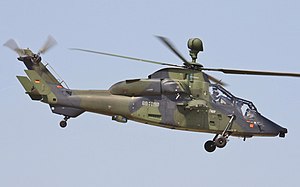Tiger helicopter
| Tiger/Tigre | |
|---|---|
 |
|
| Eurocopter Tiger | |
| Role | Attack helicopter |
| National origin | Germany / France / Spain |
| Manufacturer |
Eurocopter Airbus Helicopters |
| First flight | 27 April 1991 |
| Introduction | 2003 |
| Status | In service |
| Primary users |
French Army Australian Army German Army Spanish Army |
| Produced | 1991–present |
| Number built | 135 as of October 2017 |
| Program cost | €14.5bn (France/Germany/Spain, FY2012) |
| Unit cost |
€27.4m (Tiger HAP, FY2013)
€36.1m (Tiger HAD, FY2013) |
|
|
|
|
|
|
|
|
The Eurocopter (now Airbus Helicopters) Tiger is a four-bladed, twin-engined attack helicopter which first entered service in 2003. It is manufactured by Eurocopter (now Airbus Helicopters), the successor company to Aérospatiale's and DASA's respective helicopter divisions, which designate it as the EC665. Following their languages, in Germany it is known as the Tiger; in France and Spain it is called the Tigre.
Development of the Tiger started during the Cold War, and it was initially intended as an anti-tank helicopter platform to be used against a Soviet ground invasion of Western Europe. During its prolonged development period the Soviet Union collapsed, but France and Germany chose to proceed with the Tiger, developing it instead as a multirole attack helicopter. It achieved operational readiness in 2008.
The Tiger has the distinction of being the first all-composite helicopter developed in Europe; even the earliest models also incorporate other advanced features such as a glass cockpit, stealth technology, and high agility to increase its survivability. Improved variants have since entered service, outfitted with more powerful engines and compatible with a wider range of weapons. Since the type's introduction to service, Tigers have been used in combat in Afghanistan, Libya, and Mali.
In 1984, the French and West German governments issued a requirement for an advanced multirole battlefield helicopter. A joint venture consisting of Aérospatiale and MBB was subsequently chosen as the preferred supplier. In 1986, the development programme was effectively cancelled due to spiralling costs; it had been officially calculated that supplying the German forces with an equivalent number of US-produced McDonnell Douglas AH-64 Apache attack helicopters would have been a considerably cheaper alternative to proceeding with development of the Tiger. According to statements by the French Defence Minister André Giraud in April 1986, the collaborative effort had become more expensive than an individual national programme and was also forecast to take longer to complete. In July 1986, a government report into the project alleged that development had become distanced from the requirements and preferences of its military customers.
...
Wikipedia
